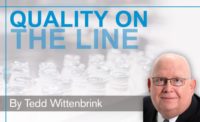The approach to quality in dairy plants has seen many changes in the last half century. Forty years ago, quality was often defined as the ability to produce a product that met regulatory requirements and had a shelf life that exceeded the use-by date on the package.
That definition has changed in 2013. Quality is often defined as the ability to produce a product at the lowest possible cost that meets regulatory requirements, is safe for the consumer and has a shelf life that exceeds the use-by date on the package.
Over the years, we have considered our quality teams to be the quality control (QC) department, the quality assurance (QA) department and total quality management (TQM) teams. More importantly, we have learned that laboratory tests do not control or assure quality, but rather are important tools for verifying that a dairy plant’s quality systems are operating properly. Simply put, you cannot test quality into a product.
As dairy products have become more complex and product shelf life requirements have increased, it has become more important to develop a quality testing program that verifies the products produced meet company as well as customer requirements and specifications. One QA program will not fit every dairy plant.
There are a multitude of tests to validate and verify quality systems. These include the classic Babcock and Gerber tests. Other tests have been developed that use infrared technology, ATP luminescence and radioactive assay technology. These are common in today’s dairy laboratory. The emphasis has been on speed and accuracy.
Quality dairy products start with quality ingredients. A program to verify that all ingredients meet quality specifications must be in place. Too often dairy plants concentrate their efforts on raw milk quality alone. While the quality of raw milk is extremely important, the quality of other ingredients such as dairy ingredients, sweeteners, and flavors cannot be overlooked. Specifications should be developed for all ingredients and a program for examining them must be in place.
The meanings of quality
The quality of ingredients and work in process must continue to be monitored in the dairy plant. Ingredient quality can deteriorate rapidly if the quality attributes are not monitored. Quality can be maintained by proper temperature control, proper storage conditions and proper rotation.
Quality during production means the products meet specifications. Whether the facility is producing standard of identity products or specialized dairy products, specifications must be met. These specifications include butterfat and total solids levels, and may also include color, flavor, appearance, percent inclusions, overrun, amount of fruit, pH, salt level, etc.
Quality in finished dairy products means consistency. Unlike fine wines, one batch of a dairy product should not be deemed a superior vintage. The goal is that every bottle of milk, every cup of yogurt and every pint of ice cream should be the same every time.
You cannot underestimate the importance of organoleptic tests at this stage and throughout the process. Does the ingredient, or finished product, look right, smell right, and taste right? Few consumers can check the pH of your product; however, all of them judge quality on these attributes.
Quality means protecting your product in storage and transit. Products are often shipped hundreds or even thousands of miles through warehouses and contract haulers. Verification that products are stored and distributed at proper temperatures is important.
Quality means food safety. Food safety goes far beyond proper pasteurization and includes sanitation, proper allergen control and labeling. Listeriaand Salmonellaare still the most feared words in the dairy industry. A robust environmental control program that includes cleaning, sanitizing, swabbing and follow-up is a necessity. Cross-contamination is another concern and includes adulteration of products with toxic chemicals, undeclared allergens and raw-into-pasteurized contamination, to name a few.
Quality in 2013 means an investment in your business. A well-developed quality program or system pays dividends by reducing the costs of rework, unsalable/returned product and product withdrawals/recalls.
So what is the meaning of quality today? Meeting the customer’s expectations the first time and every time.
For More Information
Learn more about Randolph Associates Inc.’s training programs, products and technical expertise by visiting the company website at www.raiconsult.com. Sign up for the following training courses:
- Sanitation Workshop, Nov. 19 to 21
- HACCP Certification Course, Dec. 2 to 4
- Implementing SQF Systems, Dec. 4 to 6
For registration and additional information, contact Kristy Clark at 205-595-6455 or email kristy.clark@raiconsult.com.

